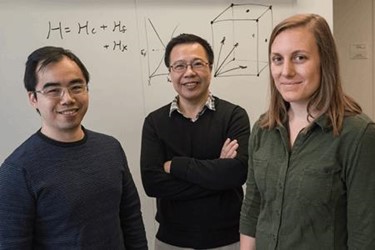Rice Scientists Find New Kind Of Quantum Material: The Weyl-Kondo Semimetal
By Jof Enriquez,
Follow me on Twitter @jofenriq

Scientists at Rice University and the Vienna University of Technology in Austria, who have been researching high-temperature superconductivity, have stumbled across a new type of quantum material they call a “Weyl-Kondo semimetal.” It exhibits theoretical properties found in disparate materials, such as topological insulators, heavy fermion metals, and high-temperature superconductors.
The electromagnetic behavior of these materials cannot be explained by classical physics, but is better understood through quantum mechanics. Scientists have been studying how these materials move across "quantum critical points" where materials are transformed from one quantum state to another, and where strange phenomena like high-temperature superconductivity occur.
“We have been absolutely fascinated by strongly correlated materials,” said physicist Qimiao Si, who leads the Rice Center for Quantum Materials (RCQM). “Collective behavior, such as quantum criticality and high-temperature superconductivity, have always been the center of our attention.”
“Over the past two years, several experimental groups have reported nontrivial topology in solid-state conducting materials, but it’s an open question whether there are conducting states that have nontrivial topology and are, at the same time, strongly interacting. No such materials have been realized, but there’s a lot of interest in looking for them,” he continued.
In the process of finding promising materials, the researchers focused on heavy-fermion semimetals, so-called because of the presence of Weyl fermions – massless particles predicted in 1929, observed experimentally for the first time in 2015, and demonstrated to be hosted in solid-state conducting materials in 2016. Rice scientists were seeking similar materials that host Weyl fermions.
“We really just stumbled upon a model in which, suddenly, we found that the mass had gone from like 1,000 times the mass of an electron to zero,” postdoctoral fellow Hsin-Hua Lai said.
With further research, the physicists discovered that their zero-mass fermions are closely tied to both strong electron correlations and nontrivial topology.
“We quickly realized that these are Weyl fermions that originate from a quintessential strong-correlation physics called the Kondo effect,” said graduate student Sarah Grefe. “We therefore dubbed this state a Weyl-Kondo semimetal.”
The Kondo effect is responsible for moving Weyl fermions by "several orders of magnitude," said Lai.
“Our findings provide the much-needed theoretical foundation for the experimental search of topological metals with strong correlations and open up an avenue for systematic studies of such quantum phases that naturally entangle multiple degrees of freedom,” the researchers stated in PNAS (Proceedings of the National Academy of Sciences of the United States of America).
Although only theorized at this point, the new type of quantum material discovered by Rice scientists could lead to practical applications in quantum computing. Because fermions are massless, they can move much faster than electrons and can conduct electricity with very little energy loss, according to Science Trends. Fermions theoretically can even replace electrons in electronic devices, making them much faster in operation.
